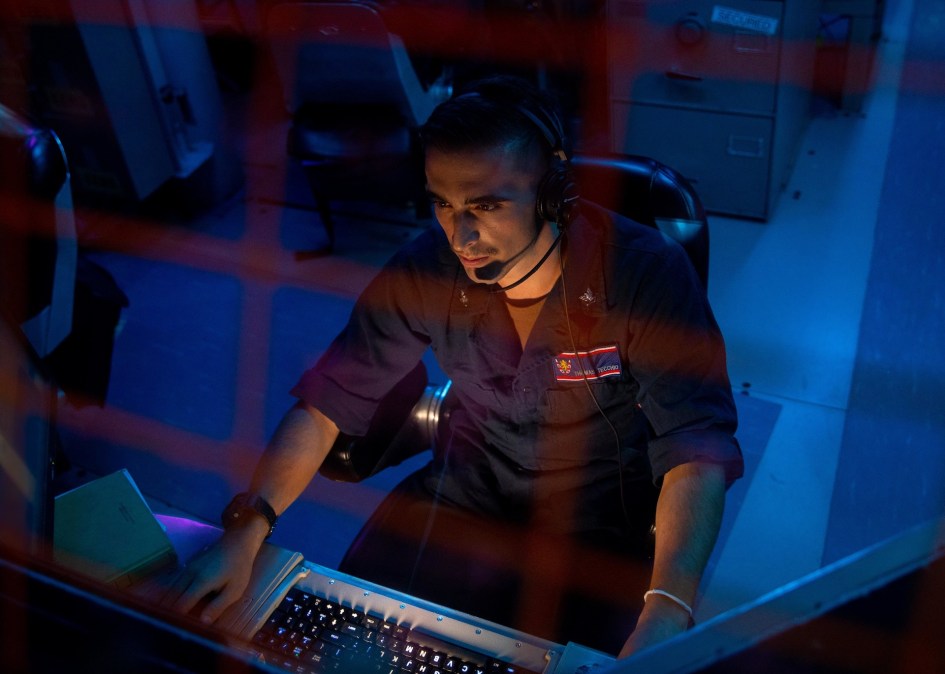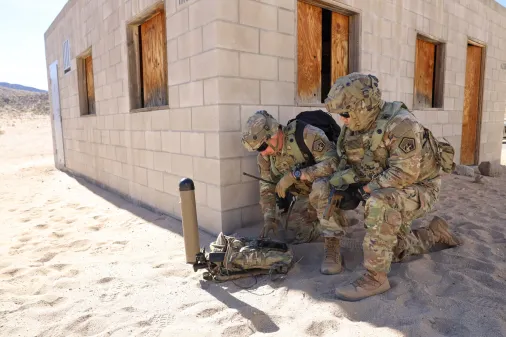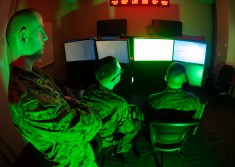Navy building out non-kinetic effects teams

SAN DIEGO, Calif. — The Navy has built a concept for specialized teams delivering non-kinetic effects in the fleet, and there’s a plan to develop more within the next two years.
The term “non-kinetic effects,” in Pentagon parlance, generally refers to capabilities that don’t blow up or explode such as cyber, electromagnetic spectrum, or space-based tools. They have come into sharper focus in recent years and the U.S. military has sought ways to expand their use and integration as a complement to more traditional weapon systems.
The Navy’s first cyber strategy, released in November, placed significant importance on non-kinetic capabilities for future warfighting, stating that they will be a deciding factor and those who effectively synchronize non-kinetic effects will have a decisive advantage on the battlefield.
“We have now matured that integration of our non-kinetic effects so significantly with the joint force maneuver that there isn’t a difference between what we do and what the traditional joint force and kinetic forces do. In fact, one can’t succeed without the other,” Vice Adm. Craig Clapperton, commander of Fleet Cyber Command, 10th Fleet and Navy Space Command, said last week at the annual WEST conference.
“We have worked very closely with [Indo-Pacific Command], [Pacific Fleet], U.S. Forces Korea and others across the Indo-Pacom theater to integrate these non-kinetic effects, synchronize them in a way that we have never been able to before, and then properly synchronize them into the joint force maneuver so that we’re providing greater battlespace awareness, we’re providing greater survivability and significantly improved targeting and lethality for the integrated force,” he added.
Clapperton, in an interview with DefenseScoop, stressed that what these teams can provide, and what the Navy is looking for, is more than just cyber tools.
“I think initially, everyone got too focused on that a non-kinetic team meant that we were going to do cyber specifically from a ship,” he said. “I’m not saying we’re not going to do that. When we talk about non-kinetic effects teams right now, cyber specifically from a ship, okay, that’s one thing, but there’s a dozen things.”
Those teams could include a mix of space, electronic warfare, and offensive and defensive cyber capabilities that can be deployed from a ship, airborne assets, fixed locations or expeditionary.
“The effects teams, I think you’re going to start seeing them be present in both deployable and expeditionary sites as well as traditional sites. You’re going to start to see more synchronization of the space, cyber and EW capabilities coming together,” Clapperton said.
This could take a variety of different directions. For example, it could be small watch teams of two to five sailors at a headquarters element operating under the authorities of Fleet Cyber Command, or a detachment of 30 to 50 sailors at an expeditionary location.
The Navy has been on a path in recent years to develop its own organic cyber forces and integrate them with additional non-kinetic capabilities.
In 2019, upon becoming the top officer in the Navy, now retired Adm. Micheal Gilday released a fragmentary operations order to the force directing, among many things, the creation of small tactical cyber teams for fleet commanders by 2020.
Last year, officials announced the intent to create fleet non-kinetic effects teams to augment afloat forces with information warfare capabilities.
U.S. Cyber Command owns the offensive cyber capabilities within the Department of Defense, and the services conduct offensive cyber ops through Cybercom and the cyber mission forces that each service provides to the command. Each of the services, in one way or another, has been developing forces and capabilities to deliver tactically focused, on-the-ground cyber and electronic warfare effects, known as radio frequency-enabled cyber.
Clapperton said some of the capabilities on the higher end could be similar to the combat mission teams (CMT) that the services provide to Cybercom — teams that conduct cyber operations on behalf of combatant commands, mostly in the offensive realm.
“Some of them might be more EW focused. Some of them might be more space focused. Then some of them might be EW focused that are not CMT trained, but might work very closely with a CMT mission element,” he said. “Maybe the CMT mission element is deployable with them, maybe they’re back at a traditional site. There’s 100 different ways to mix that combination together.”
As the Navy builds out these forces, Clapperton said it needs an enabling infrastructure between them and his headquarters, given he owns the authorities within the service.
“I don’t want a three-star headquarters trying to command and control, say, an O4 [detachment] across the globe. I need an O5, O6 command structure that enables and guides in between,” he said, referring to lieutenant commander, commander and captain levels in the Navy. “We’ll be following that as we work with [Naval Information Forces] and the Navy of exactly how we want to do the command structure that’s going to go in between it.”
That command-and-control and authority must flow back through Clapperton’s command, given the sensitive nature of many of these digital operations.
While there are some local or proximal effects and operations that cyber can perform, most of them occur beyond traditional geographic boundaries and must be carefully synchronized.
“The majority of those things tend to have effect in a much broader construct, across a significant piece of the [area of responsibility] or a joint operation area,” he said. “If given that that’s the case, you have to be very careful about letting a very small, hyper-focused tactical unit drive that kind of stuff. Because while it might seem like a great idea for them, well in the broader scape, hey, that wasn’t the right time to do it and had you synchronized that with other things and done it a little bit later, a little bit sooner, in a different way, it would have been more impactful. That’s why we get a little worried about trying to drive that down too far.”
Integration of space
While 10th Fleet had been the Navy’s space entity for years, this past January it officially also became Navy Space, the service’s component for U.S. Space Command. Increasingly, space-based capabilities are falling into the fold of information warfare within the Defense Department. The Marine Corps has also made its cyber component its space component as well.
This approach from the Department of the Navy allows unique insights and integration of all these non-kinetic capabilities.
“From our perspective, bringing that space piece in with cyber — and I think MARFOR sees it in the same way, so in the naval perspective — that yes, it has forced us to think in a very integrated way. Hey, I don’t want to just look at a cyber aspect, I don’t want to just look at an EW or a space or in an information ops aspect. We have authorities across all of them,” Clapperton said. “Putting them all together has really forced us to do that and it sort of empowered us to do it in different ways.”
As Fleet Cyber is building out its space portion and bringing on space personnel — for which the office of the chief of naval operations approved missions, functions and tasks that are driving the manpower — it is seeking to build integrated firing elements to help operational organizations understand and integrate non-kinetic capabilities.
“These integrated firing elements would then be pushed forward to Echelon II and III headquarters and work with that staff,” Clapperton said, which could include a numbered fleet or even a combatant command staff. “The integrated firing element, that’s more of the operational planning and joint fires integration element. They should be in the planning of the O-Plan, they should be in the [concept of operations] development, the CON employment development and then no kidding, actual operationalization of it, but that’s at the staff level.”






